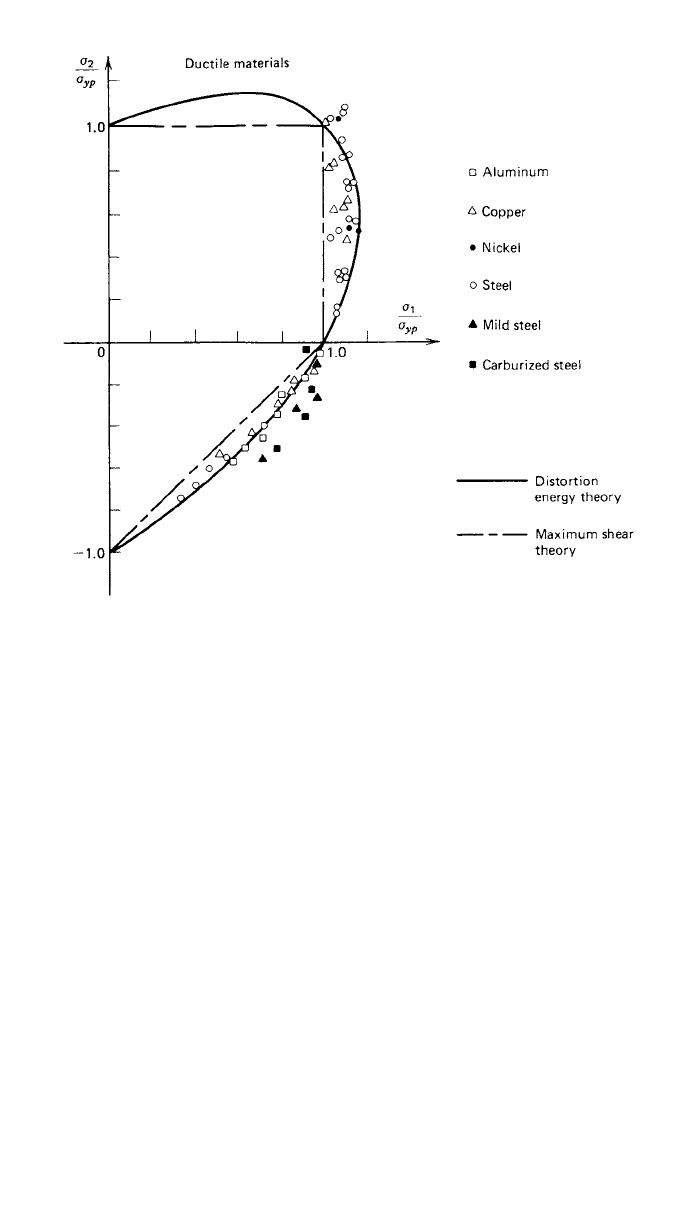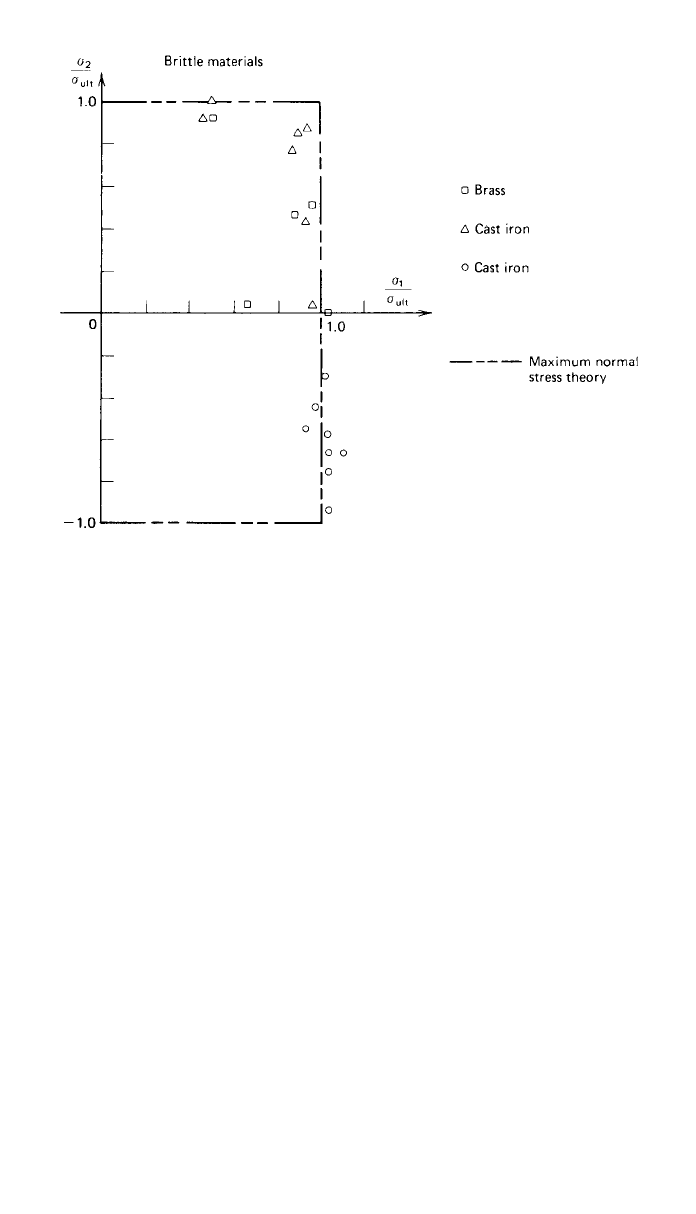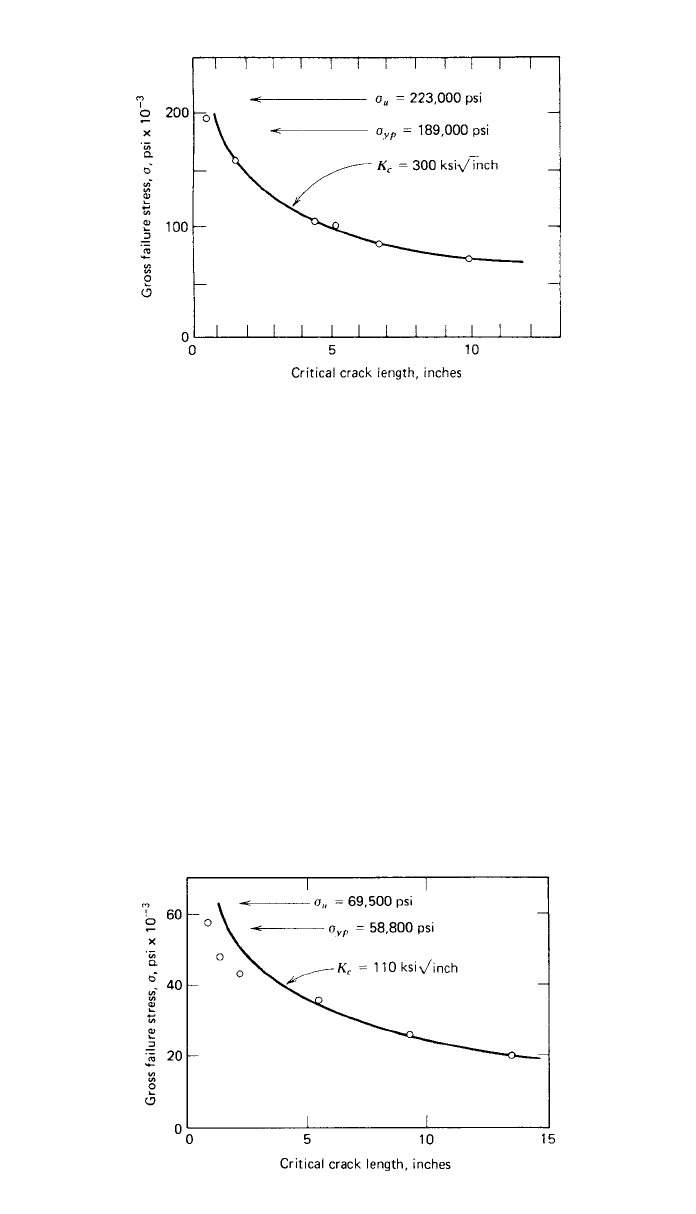Kutz M. Handbook of materials selection
Подождите немного. Документ загружается.


2 FAILURE MODES 709
ifests itself as pitting, cracking, and spalling of the contacting surfaces as a result
of the cyclic Hertz contact stresses that result in maximum values of cyclic shear
stresses slightly below the surface. The cyclic subsurface shear stresses generate
cracks that propagate to the contacting surface, dislodging particles in the pro-
cess to produce surface pitting. This phenomenon is often viewed as a type of
wear. Impact fatigue, corrosion fatigue, and fretting fatigue are described later.
Corrosion failure, a very broad term, implies that a machine part is rendered
incapable of performing its intended function because of the undesired deterio-
ration of the material as a result of chemical or electrochemical interaction with
the environment. Corrosion often interacts with other failure modes such as wear
or fatigue. The many forms of corrosion include the following. Direct chemical
attack, perhaps the most common type of corrosion, involves corrosive attack
of the surface of the machine part exposed to the corrosive media, more or less
uniformly over the entire exposed surface. Galvanic corrosion is an accelerated
electrochemical corrosion that occurs when two dissimilar metals in electrical
contact are made part of a circuit completed by a connecting pool or film of
electrolyte or corrosive medium, leading to current flow and ensuing corrosion.
Crevice corrosion is the accelerated corrosion process highly localized within
crevices, cracks, or joints where small volume regions of stagnant solution are
trapped in contact with the corroding metal. Pitting corrosion is a very localized
attack that leads to the development of an array of holes or pits that penetrate
the metal. Intergranular corrosion is the localized attack occurring at grain
boundaries of certain copper, chromium, nickel, aluminum, magnesium, and zinc
alloys when they are improperly heat treated or welded. Formation of local
galvanic cells that precipitate corrosion products at the grain boundaries seri-
ously degrades the material strength because of the intergranular corrosive pro-
cess. Selective leaching is a corrosion process in which one element of a solid
alloy is removed, such as in dezincification of brass alloys or graphitization of
gray cast irons. Erosion corrosion is the accelerated chemical attack that results
when abrasive or viscid material flows past a containing surface, continuously
baring fresh, unprotected material to the corrosive medium. Cavitation corrosion
is the accelerated chemical corrosion that results when, because of differences
in vapor pressure, certain bubbles and cavities within a fluid collapse adjacent
to the pressure-vessel walls, causing particles of the surface to be expelled,
baring fresh, unprotected surface to the corrosive medium. Hydrogen damage,
while not considered to be a form of direct corrosion, is induced by corrosion.
Hydrogen damage includes hydrogen blistering, hydrogen embrittlement, hydro-
gen attack, and decarburization. Biological corrosion is a corrosion process that
results from the activity of living organisms, usually by virtue of their processes
of food ingestion and waste elimination, in which the waste products are cor-
rosive acids or hydroxides. Stress corrosion, an extremely important type of
corrosion, is described separately later.
Wear is the undesired cumulative change in dimensions caused by the gradual
removal of discrete particles from contacting surfaces in motion, usually sliding,
predominantly as a result of mechanical action. Wear is not a single process,
but a number of different processes that can take place by themselves or in
combination, resulting in material removal from contacting surfaces through a
complex combination of local shearing, plowing, gouging, welding, tearing, and

710 FAILURE MODES
others. Adhesive wear takes place because of high local pressure and welding
at asperity contact sites, followed by motion-induced plastic deformation and
rupture of asperity functions, with resulting metal removal or transfer. Abrasive
wear takes place when the wear particles are removed from the surface by the
plowing, gouging, and cutting action of the asperities of a harder mating surface
or by hard particles entrapped between the mating surfaces. When the conditions
for either adhesive wear or abrasive wear coexist with conditions that lead to
corrosion, the processes interact synergistically to produce corrosive wear.As
described earlier, surface fatigue wear is a wear phenomenon associated with
curved surfaces in rolling or sliding contact, in which subsurface cyclic shear
stresses initiate microcracks that propagate to the surface to spall out macro-
scopic particles and form wear pits. Deformation wear arises as a result of
repeated plastic deformation at the wearing surfaces, producing a matrix of
cracks that grow and coalesce to form wear particles. Deformation wear is often
caused by severe impact loading. Impact wear is impact-induced repeated elastic
deformation at the wearing surface that produces a matrix of cracks that grows
in accordance with the surface fatigue description just given. Fretting wear is
described later.
Impact failure results when a machine member is subjected to nonstatic loads
that produce in the part stresses or deformations of such magnitude that the
member no longer is capable of performing its function. The failure is brought
about by the interaction of stress or strain waves generated by dynamic or sud-
denly applied loads, which may induce local stresses and strains many times
greater than would be induced by the static application of the same loads. If the
magnitudes of the stresses and strains are sufficiently high to cause separation
into two or more parts, the failure is called impact fracture. If the impact pro-
duces intolerable elastic or plastic deformation, the resulting failure is called
impact deformation. If repeated impacts induce cyclic elastic strains that lead to
initiation of a matrix of fatigue cracks, which grows to failure by the surface
fatigue phenomenon described earlier, the process is called impact wear. If fret-
ting action, as described in the next paragraph, is induced by the small lateral
relative displacements between two surfaces as they impact together, where the
small displacements are caused by Poisson strains or small tangential ‘‘glancing’’
velocity components, the phenomenon is called impact fretting. Impact fatigue
failure occurs when impact loading is applied repetitively to a machine member
until failure occurs by the nucleation and propagation of a fatigue crack.
Fretting action may occur at the interface between any two solid bodies when-
ever they are pressed together by a normal force and subjected to small-
amplitude cyclic relative motion with respect to each other. Fretting usually takes
place in joints that are not intended to move but, because of vibrational loads
or deformations, experience minute cyclic relative motions. Typically, debris
produced by fretting action is trapped between the surfaces because of the small
motions involved. Fretting fatigue failure is the premature fatigue fracture of a
machine member subjected to fluctuating loads or strains together with condi-
tions that simultaneously produce fretting action. The surface discontinuities and
microcracks generated by the fretting action act as fatigue crack nuclei that
propagate to failure under conditions of fatigue loading that would otherwise be
acceptable. Fretting fatigue failure is an insidious failure mode because the fret-

2 FAILURE MODES 711
ting action is usually hidden within a joint where it cannot be seen and leads to
premature, or even unexpected, fatigue failure of a sudden and catastrophic na-
ture. Fretting wear failure results when the changes in dimensions of the mating
parts, because of the presence of fretting action, become large enough to interfere
with proper design function or large enough to produce geometrical stress con-
centration of such magnitude that failure ensues as a result of excessive local
stress levels. Fretting corrosion failure occurs when a machine part is rendered
incapable of performing its intended function because of the surface degradation
of the material from which the part is made, as a result of fretting action.
Creep failure results whenever the plastic deformation in a machine member
accrues over a period of time under the influence of stress and temperature until
the accumulated dimensional changes interfere with the ability of the machine
part to satisfactorily perform its intended function. Three stages of creep are
often observed: (1) transient or primary creep during which time the rate of
strain decreases, (2) steady-state or secondary creep during which time the rate
of strain is virtually constant, and (3) tertiary creep during which time the creep
strain rate increases, often rapidly, until rupture occurs. This terminal rupture is
often called creep rupture and may or may not occur, depending on the stress–
time–temperature conditions.
Thermal relaxation failure occurs when the dimensional changes due to the
creep process result in the relaxation of a prestrained or prestressed member
until it no longer is able to perform its intended function. For example, if the
prestressed flange bolts of a high-temperature pressure vessel relax over a period
of time because of creep in the bolts, so that, finally, the peak pressure surges
exceed the bolt preload to violate the flange seal, the bolts will have failed
because of thermal relaxation.
Stress rupture failure is intimately related to the creep process except that the
combination of stress, time, and temperature is such that rupture into two parts
is ensured. In stress rupture failures the combination of stress and temperature
is often such that the period of steady-state creep is short or nonexistent.
Thermal shock failure occurs when the thermal gradients generated in a ma-
chine part are so pronounced that differential thermal strains exceed the ability
of the material to sustain them without yielding or fracture.
Galling failure occurs when two sliding surfaces are subjected to such a
combination of loads, sliding velocities, temperatures, environments, and lubri-
cants that massive surface destruction is caused by welding and tearing, plowing,
gouging, significant plastic deformation of surface asperities, and metal transfer
between the two surfaces. Galling may be thought of as a severe extension of
the adhesive wear process. When such action results in significant impairment
to intended surface sliding or in seizure, the joint is said to have failed by galling.
Seizure is an extension of the galling process to such severity that the two parts
are virtually welded together so that relative motion is no longer possible.
Spalling failure occurs whenever a particle is spontaneously dislodged from
the surface of a machine part so as to prevent the proper function of the member.
Armor plate fails by spalling, for example, when a striking missile on the ex-
posed side of an armor shield generates a stress wave that propagates across the
plate in such a way as to dislodge or spall a secondary missile of lethal potential
on the protected side. Another example of spalling failure is manifested in rolling

712 FAILURE MODES
contact bearings and gear teeth because of the action of surface fatigue as de-
scribed earlier.
Radiation damage failure occurs when the changes in material properties
induced by exposure to a nuclear radiation field are of such a type and magnitude
that the machine part is no longer able to perform its intended function, usually
as a result of the triggering of some other failure mode, and often related to loss
in ductility associated with radiation exposure. Elastomers and polymers are
typically more susceptible to radiation damage than are metals, whose strength
properties are sometimes enhanced rather than damaged by exposure to a radi-
ation field, although ductility is usually decreased.
Buckling failure occurs when, because of a critical combination of magnitude
and/or point of load application, together with the geometrical configuration of
a machine member, the deflection of the member suddenly increases greatly with
only a slight change in load. This nonlinear response results in a buckling failure
if the buckled member is no longer capable of performing its design function.
Creep buckling failure occurs when, after a period of time, the creep process
results in an unstable combination of the loading and geometry of a machine
part so that the critical buckling limit is exceeded and failure ensues.
Stress corrosion failure occurs when the applied stresses on a machine part
in a corrosive environment generate a field of localized surface cracks, usually
along grain boundaries, that render the part incapable of performing its function,
often because of triggering some other failure mode. Stress corrosion is a very
important type of corrosion failure mode because so many different metals are
susceptible to it. For example, a variety of iron, steel, stainless-steel, copper, and
aluminum alloys are subject to stress corrosion cracking if placed in certain
adverse corrosive media.
Corrosion wear failure is a combination failure mode in which corrosion and
wear combine their deleterious effects to incapacitate a machine part. The cor-
rosion process often produces a hard, abrasive corrosion product that accelerates
the wear, while the wear process constantly removes the protective corrosion
layer from the surface, baring fresh metal to the corrosive medium and thus
accelerating the corrosion. The two modes combine to make the result more
serious than either of the modes would have been otherwise.
Corrosion fatigue is a combination failure mode in which corrosion and
fatigue combine their deleterious effects to cause failure of a machine part. The
corrosion process often forms pits and surface discontinuities that act as stress
raisers that in turn accelerate fatigue failure. Furthermore, cracks in the usually
brittle corrosion layer also act as fatigue crack nuclei that propagate into the
base material. On the other hand, the cyclic loads or strains cause cracking and
flaking of the corrosion layer, which bares fresh metal to the corrosive medium.
Thus, each process accelerates the other, often making the result disproportion-
ately serious.
Combined creep and fatigue failure is a combination failure mode in which
all of the conditions for both creep failure and fatigue exist simultaneously, each
process influencing the other to produce failure. The interaction of creep and
fatigue is probably synergistic but is not well understood.
3 ELASTIC DEFORMATION AND YIELDING
Small changes in the interatomic spacing of a material, induced by applied forces
or changing temperatures, are manifested macroscopically as elastic strain. Al-

3 ELASTIC DEFORMATION AND YIELDING 713
though the maximum elastic strain in crystalline solids, including engineering
metals, is typically very small, the force required to produce the small strain is
usually large; hence, the accompanying stress is large. For uniaxial loading of
a machine or structural element, the total elastic deformation of the member may
be found by integrating the elastic strain over the length of the element. Thus,
for a uniform bar subjected to uniaxial loading the total deformation of the bar
in the axial direction is
⌬l ⫽ l (1)
where
⌬l is total axial deformation of the bar, l is the original bar length, and
is the axial elastic strain. If ⌬ l exceeds the design-allowable axial deformation,
failure will occur. For example, if the axial deformation of an aircraft gas-turbine
blade, due to the centrifugal force field, exceeds the tip clearance gap, failure
will occur because of force-induced elastic deformation. Likewise, if thermal
expansion of the blade produces a blade-axial deformation that exceeds the tip
clearance gap, failure will occur because of temperature-induced elastic defor-
mation.
When the state of stress is more complicated, it becomes necessary to cal-
culate the elastic strains induced by the multiaxial states of stress in three mu-
tually perpendicular directions through the use of the generalized Hooke’s law
equations for isotropic materials:
1
⫽ [
⫺
(
⫹
)]
xxyz
E
1
⫽ [
⫺
(
⫹
)] (2)
yyxz
E
1
⫽ [
⫺
(
⫹
)]
zzxy
E
where
x
,
y
, and
z
are the normal stresses in the three coordinate directions,
E and
are Young’s modulus and Poisson’s ratio, respectively, and
x
,
y
, and
z
are the elastic strains in the three coordinate directions. Again, total elastic
deformation of a member in any of the coordinate directions may be found by
integrating the strain over the member’s length in that direction. If the change
in length of the member in any direction exceeds the design-allowable defor-
mation in that direction, failure will occur. The use of commercial finite-element
analysis software packages is one commonly used means of determining both
the elastic strains produced in a structural element and the subsequent elastic
deformations produced.
If applied loads reach certain critical levels, the atoms within the microstruc-
ture may be moved into new equilibrium positions and the induced strains are
not fully recovered upon release of the loads. Such permanent strains, usually
the result of slip, are called plastic strains, and the macroscopic permanent de-
formation due to plastic strain is called yielding. If applied loads are increased
even more, the plastic deformation process may be carried to the point of insta-

714 FAILURE MODES
bility where necking begins: Internal voids form and slowly coalesce to finally
produce a ductile rupture of the loaded member.
After plastic deformation has been initiated, Eqs. (2) are no longer valid and
the predictions of plastic strains and deformations under multiaxial states of
stress are more difficult. If a designer can tolerate a prescribed plastic defor-
mation without experiencing failure, these plastic deformations may be deter-
mined using plasticity theory. Many commercial finite-element analysis software
packages now posses the capability to compute both plastic strains and defor-
mations for a prescribed nonlinear elastic-plastic constitutive relation.
For the case of simple uniaxial loading, the onset of yielding may be accu-
rately predicted to occur when the uniaxial normal stress reaches a value equal
to the yield strength of the material read from an engineering stress–strain curve.
If the loading is more complicated, and a multiaxial state of stress is produced
by the loads, the onset of yielding may no longer be predicted by comparing
any one of the normal stress components with uniaxial material yield strength,
not even the maximum principal normal stress. Onset of yielding for multiaxially
stressed critical points in a machine or structure is more accurately predicted
through the use of a combined stress theory of failure, which has experimentally
been validated for the prediction of yielding. The two most widely accepted
theories for predicting the onset of yielding are the distortion energy theory (also
called the octahedral shear stress theory or the von Mises criterion) and the
maximum shearing stress theory (also called the Tresca criterion). The distortion
energy theory is somewhat more accurate while the maximum shearing stress
theory may be slightly easier to use and is more conservative .
In words, the distortion energy theory may be expressed as follows: Failure
is predicted to occur in the multiaxial state of stress when the distortion energy
per unit volume becomes equal to or exceeds the distortion energy per unit
volume at the time of failure in a simple uniaxial stress test using a specimen
of the same material.
Mathematically, the distortion energy theory may be formulated as: Failure
is predicted by the distortion energy theory to occur if
2222
(
⫺
) ⫹ (
⫺
) ⫹ (
⫺
) ⱖ 2
(3)
12 13 31 ƒ
The maximum shearing stress theory may be stated in words as: Failure is
predicted to occur in the multiaxial state of stress when the maximum shearing
stress magnitude becomes equal to or exceeds the maximum shearing stress
magnitude at the time of failure in a simple uniaxial stress test using a specimen
of the same material.
Mathematically, the maximum shearing stress theory becomes: Failure is pre-
dicted by the maximum shearing stress theory to occur if
⫺
ⱖ
(4)
13ƒ
where
1
,
2
, and
3
are the principal stresses at a point, ordered such that
1
ⱖ
2
ⱖ
3
,
ƒ
is the uniaxial failure strength in tension.
Comparisons of these two failure theories with experimental data on yielding
are shown in Fig. 1 for a variety of materials and different biaxial states of
stress.

4 FRACTURE MECHANICS AND UNSTABLE CRACK GROWTH 715
Fig. 1 Comparison of biaxial yield strength data with theories of failure for
a variety of ductile materials.
4 FRACTURE MECHANICS AND UNSTABLE CRACK GROWTH
When the material behavior is brittle rather than ductile, the mechanics of the
failure process are much different. Instead of the slow coalescence of voids
associated with ductile rupture, brittle fracture proceeds by the high-velocity
propagation of a crack across the loaded member. If the material behavior is
clearly brittle, fracture may be predicted with reasonable accuracy through use
of the maximum normal stress theory of failure. In words, the maximum normal
stress theory may be expressed as follows: Failure is predicted to occur in the
multiaxial state of stress when the maximum principal normal stress becomes
equal to or exceeds the maximum normal stress at the time of failure in a simple
uniaxial stress test using a specimen of the same material.
Mathematically, the maximum normal stress theory becomes: Failure is pre-
dicted by the maximum normal stress theory to occur if
ⱖ
兩
兩 ⱖ
(5)
1 t 3 c
where
1
,
2
, and
3
are the principal stresses at a point, ordered such that
1
ⱖ
2
ⱖ
3
,
t
is the uniaxial failure strength in tension, and
c
is the uniaxial
failure strength in compression. Comparison of this failure theory with experi-
mental data on brittle fracture for different biaxial states of stress is shown in
Fig. 2.

716 FAILURE MODES
Fig. 2 Comparison of biaxial brittle fracture strength data with maximum normal stress theory
for several brittle materials.
On the other hand, more recent experience has led to the understanding that
nominally ductile materials may also fail by a brittle fracture response in the
presence of cracks or flaws if the combination of crack size, geometry of the
part, temperature, and/or loading rate lies within certain critical regions. Fur-
thermore, the development of higher-strength structural alloys, the wider use of
welding, and the use of thicker sections in some cases have combined their
influence to reduce toward a critical level the capacity of some structural mem-
bers to accommodate local plastic strain without fracture. At the same time,
fabrication by welding, residual stresses due to machining, and assembly mis-
match in production have increased the need for accommodating local plastic
strain to prevent failure. Fluctuating service loads of greater severity and more
aggressive environments have also contributed to unexpected fractures.
An important observation in studying fracture behavior is that the magnitude
of the nominal applied stress that causes fracture is related to the size of the
crack or cracklike flaw within the structure.
2–4
For example, observations of the
behavior of central through-the-thickness cracks, oriented normal to the applied
tensile stress in steel and aluminum plates, yielded the results shown in Figs. 3
and 4. In these tests, as the tensile loading on the precracked plates was slowly
increased, the crack initially extended slowly for a time and then abruptly ex-
tended to failure by rapid crack propagation. The slow stable crack growth or
tearing was characterized by speeds of the order of fractions of an inch per
minute. The rapid crack propagation was characterized by speeds of the order
of hundreds of feet per second. The data of Figs. 3 and 4 indicate that for longer
initial crack lengths the fracture stress (the stress corresponding to the onset of
stable tearing) was lower. For the aluminum alloy the fracture stress was less

4 FRACTURE MECHANICS AND UNSTABLE CRACK GROWTH 717
Fig. 3 Influence of crack length on gross failure stress for center-cracked steel plate.
(After Ref. 5, copyright ASTM, adapted with permission)
Fig. 4 Influence of crack length on gross failure stress for center-cracked aluminum plate.
(After Ref. 5, copyright ASTM, adapted with permission)
than the yield strength for cracks longer than about 0.75 in. For the steel alloy
the fracture stress was less than the yield strength for cracks longer than about
0.5 in. In both cases, for shorter cracks the fracture stress approaches the ultimate
strength of the material determined from a conventional uniaxial tension test.
Experience has shown that the onset of stable tearing establishes an important
material property termed fracture toughness. The fracture toughness may be used
as a design criterion in fracture prevention, just as the yield strength is used as
a design criterion in prevention of yielding of a ductile material under static
loading. It should be noted that not all materials and or specimen types exhibit
stable tearing. Many materials and or specimen configurations exhibit rapid
crack propagation without any evidence of prior stable tearing.
In many cases slow crack propagation occurs by means other than stable
tearing, especially under conditions of fluctuating loads and/or aggressive en-
vironments. In analyses and predictions involving fatigue failure phenomena,

718 FAILURE MODES
characterization of the rate of slow crack extension and the initial flaw size,
together with critical crack size, are used to determine the useful life of a com-
ponent or structure subjected to fluctuating loads. The topic of fatigue crack
propagation is discussed further in Section 5.
The simplest useful model for the stresses near the tip of a crack is based on
the assumptions of linear elastic material behavior and a two-dimensional anal-
ysis; thus, the procedure is often referred to as linear elastic fracture mechanics.
Although the validity of the linear elastic assumption may be questioned in view
of plastic zone formation at the tip of a crack in any real engineering material,
as long as small-scale yielding occurs, that is, as long as the plastic zone size
remains small compared to the dimensions of the crack, the linear elastic model
gives good engineering results. Thus, the small-scale yielding concept implies
that the small plastic zone is confined within a linear elastic field surrounding
the crack tip. If the material properties, section size, loading conditions, and
environment combine in such a way that large-scale plastic zones are formed,
the basic assumptions of linear elastic fracture mechanics are violated, and
elastic-plastic fracture mechanics methods must be employed.
4
Three basic types of stress fields can be defined for crack-tip stress analysis,
each one associated with a distinct mode of crack deformation, as illustrated in
Fig. 5. The opening mode, mode I, is associated with local displacement in
which the crack surfaces move directly apart, as shown in Fig. 5a. The sliding
mode, mode II, is developed when crack surfaces slide over each other in a
direction perpendicular to the leading edge of the crack, as shown in Fig. 5b.
The tearing mode, mode III, is characterized by crack surfaces sliding with
respect to each other in a direction parallel to the leading edge of the crack, as
shown in Fig. 5c. Superposition of these three modes will fully describe the
most general three-dimensional case of local crack-tip deformation and stress
field, although mode I is most common.
In terms of the coordinates shown in Fig. 6, the stresses near the crack tip
for mode I loading may be written as
2
K
3
I
⫽ cos 1 ⫺ sin sin (6)
冋册
x
222
兹2
r
K
3
I
⫽ cos 1 ⫹ sin sin (7)
冋册
y
222
兹2
r
K
3
I
⫽ sin cos cos (8)
xy
22 2
兹2
r
The parameter K
I
is known as the mode I stress intensity factor. This parameter
represents the strength of the stress field surrounding the tip of the crack. Since
fracture is induced by the crack-tip stress field, the stress intensity factor is the
primary correlation parameter used in current practice.
In general, the expressions for the stress intensity factor are of the form
K ⫽ C
兹
a (9)
I
where a is the crack size,
is the gross-section stress, and C is dependent on
